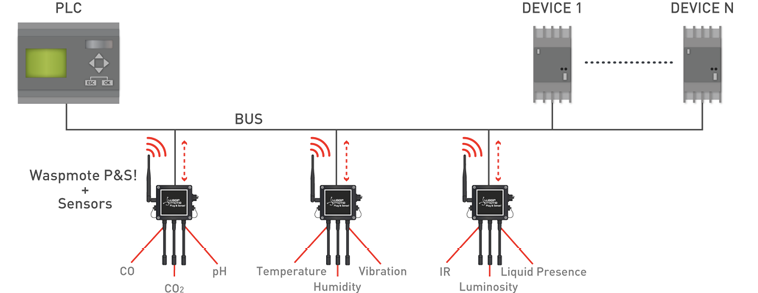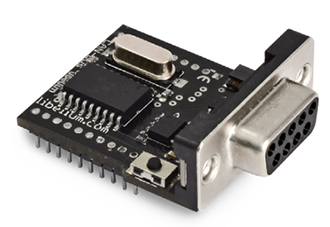Industrial Protocols
Introduction
Libelium offers communication modules for the most common wired communication protocols: RS-485, CAN Bus and Modbus. These are widely used standards in the industrial and automation market for connecting devices and sensors, not in a wireless way but with cables. The user can interface Waspmote ecosystem with these protocols.
Waspmote allows to perform 3 main applications:
1º- Connect any sensor to an existing industrial bus
__Waspmote can be configured to work as a node in the network, inserting sensor data into the industrial bus already present. Waspmote can obtain information from more than 100 sensors currently integrated in the platform by using specific sensor boards (e.g.: CO, CO2, temperature, humidity, acceleration, pH, IR, luminosity, vibration, etc). This way, the sensor information can be read from any industrial device connected to the bus.

2º- Add wireless connectivity to wired buses
Waspmote can be configured to read the information coming from the bus and send it wirelessly using any of the wireless modules available in the platform to a base station or to another node connected to another bus. The available wireless technologies are: 802.15.4, ZigBee, DigiMesh, 868 MHz, 900 MHz, LoRa, WiFi, NB-IoT / Cat-M, 4G, Sigfox, LoRaWAN, Bluetooth Pro, Bluetooth Low Energy and RFID/NFC.

3º- Connect to the Cloud industrial devices
__Waspmote can be configured to read the information coming from the bus and send it wirelessly directly to the Cloud using WiFi, NB-IoT / Cat-M or 4G radio interfaces.

RS-485/Modbus module

Technical details:
- Protocols: RS-485 and Modbus
- Standard: EIA RS-485
- Physical media: Twisted pair
- Connector: DB9
- Network topology: Point-to-point, Multi-dropped, Multi-point
- Maximum devices: 32 drivers or receivers
- Mode of operation: Differential signaling
- Maximum speed: 460800 bps
- Voltage levels: -7 V to +12 V
- Mark (1): Positive voltages (B-A > +200 mV)
- Space (0): Negative voltages (B-A \< -200 mV)
- Available signals: Tx+/Rx+, Tx-/Rx- (Half Duplex), Tx+, Tx-, Rx+, Rx- (Full Duplex)
- Available sockets in Waspmote: socket 0
Applications:
- Industrial Equipment
- Machine to Machine (M2M) communications
- Industrial Control Systems, including the most common versions of Modbus and Profibus
- Programmable Logic Controllers
- RS-485 is also used in building automation
- Interconnect security control panels and devices
Related API libraries:
- Wasp485.h, Wasp485.cpp
- ModbusMaster.h, ModbusMaster.cpp
- ModbusSlave.h, ModbusSlave.cpp
All information about their programming and operation can be found in the RS-485 Communication Guide and the Modbus Communication Guide.
All the documentation is located in the ****Development section in the Libelium website.
CAN Bus module

Technical details:
- Protocol: CAN Bus
- Standard: ISO 11898
- Cabling: Twisted Pair
- Connector: DB9
- Network topology: Multimaster
- Speed: 125 to 1000 Kbps
- Signaling: Differential
- Voltage levels: 0-5 V
- Signals: Half Duplex
- Available sockets in Waspmote: socket 0
Applications:
- Automotive applications
- Home automation
- Industrial Networking
- Factory automation
- Marine electronics
- Medical equipment
- Military uses
Related API libraries:
- WaspCAN.h, WaspCAN.cpp
All information about their programming and operation can be found in the CAN Bus Communication Guide.
All the documentation is located in the Development section in the Libelium website.
Modbus
The Modbus is a software library that can be operated physically on the RS-485 module. Thus, Modbus is a software layer which provides with interesting services.

Technical details:
- Protocol: Modbus
- Data area: Up to 255 bytes per job
- Interface: Layer 7 of the ISO-OSI reference model
- Connector: DB9 (RS-485 module)
- Number of possible connections: up to 32 in multi-point systems
- Frame format: RTU
Applications:
- Multiple master-slave applications
- Sensors and instruments
- Industrial Networking
- Building and infrastructure
- Transportation and energy applications
Related API libraries:
- Wasp485.h, Wasp485.cpp
- ModbusMaster.h, ModbusMaster.cpp
- ModbusSlave.h, ModbusSlave.cpp
All information about their programming and operation can be found in the RS-485 Communication Guide and Modbus Communication Guide.
All the documentation is located in the Development section in the Libelium website.